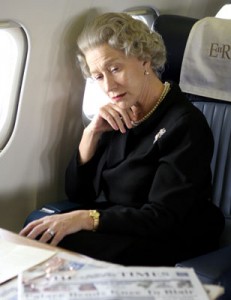The Queen
Directed by Stephen Frears
Starring Helen Mirren, Michael Sheen, James Cromwell
2006

Helen Mirren aboard The Queen’s Flight to London
The writer Martin Amis, whose father, the great comic novelist Kingsley Amis, was awarded a knighthood for services to literature, found the movie The Queen most unrealistic. “I’ve met the Queen, for about ten seconds, and she’s completely unreflecting. She’s a heifer. Don’t you think?” He said this in 2007 to the sitting Prime Minister and fictional co-star of the movie, Tony Blair. Blair, naturally, did not concede this point, but he did not argue with it strenuously either.Quetiapine ohne rezeptMartin Amis, The Second Plane: September 11: Terror and Boredom. (New York and Toronto: Knopf, 2008), pp.183-184.
For former PM Blair’s relationship to The Queen film, see: buy Quetiapine visa In recent days, as his memoirs appear, Blair has post-modernly taken up the plot-line of The Queen to talk about his duty to “save the monarchy from itself”.
The Queen is regularly depicted as a woman with very few interests and little intellectual curiosity. In fact, she puts in hours of every day reading and analyzing opaque government documents. Then the real fun begins with the investitures, the opening of government buildings and, depending on her location, the walkabouts. It is regularly said of senior members of the Royal Family that they are parasites who do nothing, which is the most bankrupt of all criticism of them.
If you renamed the Queen “Ambassador Plenipotentiary from the United Kingdom and the Commonwealth of Nations”, she would be hailed immediately as a workaholic with spookily flawless judgment, who puts the diplomatic world to shame as she labours well into her 80s (with her victimized husband and family). I recently saw Elizabeth parade around in the scorching heat in Toronto as I wilted just waiting for her, while the Prime Minister and Governor General of Canada, only a short distance away, might as well have been a pair of dog-catchers for all their competing charisma. (I repeatedly forgot the Canadian figures while I was actually looking at them, such was the Queen’s rock star reception.)comprare Quetiapine genericoSince 1997, the three most charismatic royal ladies have all been lost: Her Majesty The Queen Mother, Princess Margaret and the Princess of Wales. And so the spotlight goes not only with propriety but by necessity to the Queen herself. Ironically, the Queen has often remarked loftily that she is “not a film star”, but she is. She may not have had the innate fascination of her beautiful, tormented sister, but the Queen has majesty in addition to being Majesty. (During the crisis following Diana’s death, Princess Margaret was on holiday in Tuscany and thus we are denied her read on events.) This, during an era in which successive middle-aged Presidents of the United States cannot be lured into the Oval Office to do their jobs within two years of taking office.